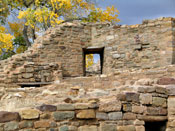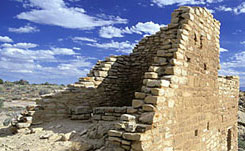Map of Colorado's National Parks,
Monuments & Grasslands

Click on the Colorado National Parks & Monuments below to view More Information

Explore the walking-only monument on the site's self-guided trail. The half-mile walk winds through the well-excavated West Ruin, where visitors can explore the building's rooms and kivas. Visitors end the walk at the Great Kiva, a re-creation of a 40-foot kiva once used as the settlement's central social and religious site. It's the largest and oldest structure of its kind in the world.
Bandelier National Monument preserves ancient settlements built by ancestral Puebloans between 1150 and 1550 at the base - and up the walls - of Frijoles Canyon. Today, visitors to the monument can get up close and personal with the Puebloans' feats of engineering. Trails throughout the monument take visitors to various excavation sites, even allowing visitors to enter the rooms, climb ladders and explore the settlements in some places.
Between Gunnison and Montrose. This steep canyon, formed over two million years of erosion, plunges up to 2,722 feet to the raging Gunnison River below. Activities range from easy - hiking, scenic overlooks and an interactive visitor's center - to extreme - rock climbing, white water rafting and kayaking.
Browns Canyon along the Arkansas River is known around the nation for its excellent rafting. With mountains, canyons, and gulches, there is no wonder why it has been designated as a National Monument.
Along the Colorado-Utah border near Dolores. Home to tribes of people from the Anasazi to the Ute, this site is now populated by more than 20,000 archaeological sites. Visitors can check out ancient dwellings, rock art, artifacts and stunning natural formations.
Visitors can tour the once-great center of Chacoan culture, and thanks to a partnership with the University of New Mexico, view ancient artifacts found at the site. A handful of hiking and bike trails also run through the park, allowing vacationers to fully take in the landscape of mountains and mesas that held deep spiritual meaning for the Puebloan people.
Near Pagosa Springs. Once home to ancestral Puebloan Indians, this village is now a major archaeological site. Visitors can explore many of the structures that have been unearthed, including a grand Kiva and several residential structures.
Near Grand Junction. This gorgeous park full of red rock formations and canyons is perfect for hiking, sightseeing, biking and wildlife-watching. Plenty of scenic drives offer breathtaking overlooks and chances to learn about the various formations.
In south-eastern Colorado near along Highway 160. From dino tracks to Comanche Indian rock art to Santa Fe Trail markers, this park contains several historic mementos marking the area's important role in Colorado's past. Visitors have their choice of recreational activities, such as hiking, biking and horseback riding.
Along the Colorado-Utah border near Dinosaur. This 210,000-acre park is home to thousands of dinosaur bones and several archaeological dig sites. Visitors will also find interesting rock art, historic homestead sites and countless recreation opportunities, including hiking trails and white water rafting tours.
Between Cripple Creek and Woodland Park. This prehistoric lake was wiped out by a volcanic eruption millions of years ago. Now, it's home to layers of sediment featuring the fossils of more than 60,000 plants and animals. Hiking trails through park are a great way to explore.
32 miles northeast of Alamosa. This 30-square-mile park is home to the nation's tallest sand dunes, towering as high as 750 feet. Visitors can hike the dunes or venture to nearby Zapata Falls. Kids and adults love splashing in Medano Creek and building sand castles.
Along the Colorado-Utah border near Dolores. Visitors can explore five Puebloan-era villages last inhabited during the 13th century, including Kivas and spectacular towers. Check out the many trails that criss-cross the park or one of the many interactive programs offered by park rangers.
Between Cortez and Mancos. Native Americans inhabited this site from 400 to 1300 before they disappeared, leaving behind breathtaking dwellings built into the sides of steep cliffs. Visitors can tour the many sites, hike the park's trails and visit its artifacts-filled museum.
Near Sterling off Highway 14. Chalky bluffs and rock formations punctuate this prairie grassland, the setting for James Michener's "Centennial." Home to many birds of prey and diversity of plant life; popular activities include hiking, horseback riding and trout fishing.
Book-ended by the towns of Grand Lake and Estes Park, this 265,828-acre, wildlife-filled park offers dozens of trails for hiking, snowshoeing, biking and cross-country skiing. The park's Trail Ridge Road is the highest continuous paved road in the world.

















